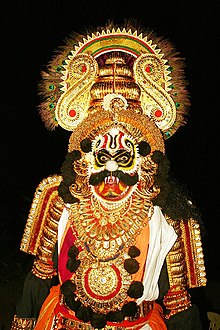Rakshasa

The rakshasas ( Sanskrit राक्षस rākṣasa ; Pali : rakkhasa m. " Destroyer ") are demons from Indian mythology . The feminine form are rakshasis (Pali: rakkhasī f. ). With the spread of Buddhism , they have found their way into the legends and folklore of many East Asian cultures.
mythology
Rakshasas are already mentioned frequently in the Rig Veda and play a decisive role in the Indian epic. They are considered enemies of humans and counterpart to the incarnations of Vishnu . Well-known examples are the Rakshasa king Ravana in Ramayana , the bitter enemy of Rama and the demonic king Kamsa , who, according to tradition, persecuted the human born Krishna and was finally overcome by him.
Like Ravana, all Rakshasas are said to have descended from the sage Pulastya , but it is also said that they sprang from the feet of the god Brahma . According to the Vishnu Purana, however, the wise Kashyapa and his wife Khasa had a son named Rakshas, from whom the Rakshasas descended.
Essence
According to the Rig Veda, the Rakshasas were nocturnal spirits who often appear as animals, such as vultures, owls, dogs or tigers, but can also appear in the form of terrifying people. As invisible spirits, they harass people and disrupt their sacrificial acts. They are said to drink blood and consume human flesh. In pictorial representations, they often have large, bloody fangs. The Ramayana describes the appearance of the Rakshasas of Lanka. According to this, they can look extremely pretty, but also terrifying and disfigured. Some have animal heads, others have multiple limbs or only one ear or eye, they can be dwarfed or huge, emaciated or fat with drooping breasts.
Although basically the embodiment of evil, some of these demons also support the good and can show themselves to be particularly cultivated and virtuous persons. In the epic Mahabharata Bhima , one of the heroic Pandavas , had a son, Ghatotkacha , with the Rakshasi Hidimbi . During his youth he lived in his mother's cannibal family, but devotedly supported his father and his family. In Ramayana it is Vibhishana, the pure-hearted brother of the evil Ravana , who provides decisive assistance in Rama's struggle. The adversary Ravana himself was also regarded as an educated, cultivated king who had many virtues.
abode
In systematic mythology, the world of Rakshasaloka is ascribed to the Rakshasas. According to popular belief, they are often in the vicinity of cremation sites. They can also live among people as people.
literature
- Rakshasa . In: John Dowson : A classical dictionary of Hindu mythology and religion, geography, history, and literature. Trübner & co., London 1879, pp. 254-255 ( Textarchiv - Internet Archive ).
- Hans Wilhelm Haussig (Ed.): Gods and Myths of the Indian Subcontinent (= Dictionary of Mythology . Department 1: The ancient civilized peoples. Volume 5). Klett-Cotta, Stuttgart 1984, ISBN 3-12-909850-X , p. 151.
Individual evidence
- ↑ rākṣasa . In: Monier Monier-Williams : Sanskrit-English Dictionary . Clarendon Press, Oxford 1899, p. 871, col. 3 .
- ↑ http://www.ramayana.pushpak.de/b5n004.html Hanuman looks at the city of Lanka
- ↑ Anneliese Keilhauer, Peter Keilhauer: The visual language of Hinduism. The Indian world of gods and their symbolism. Dumont Buchverlag, Cologne, p. 234.
- ↑ Anneliese Keilhauer, Peter Keilhauer: The visual language of Hinduism. The Indian world of gods and their symbolism. Dumont Buchverlag, Cologne, p. 235.
